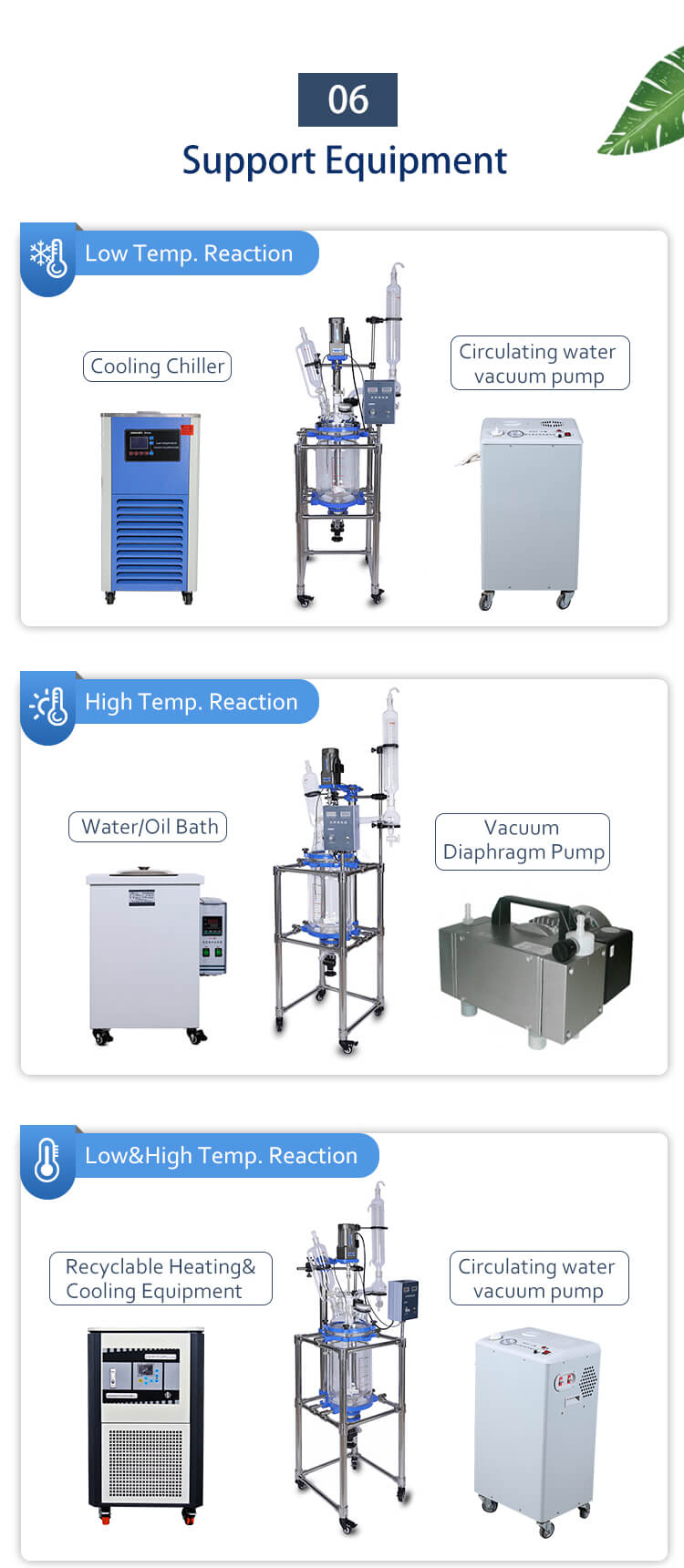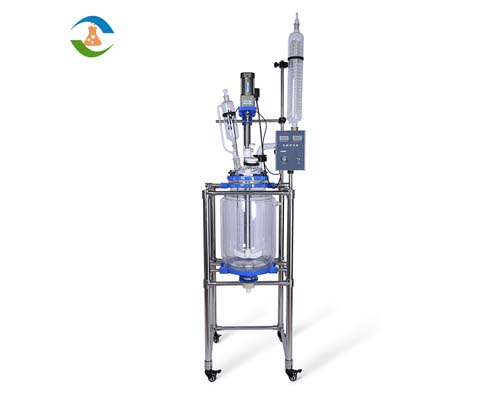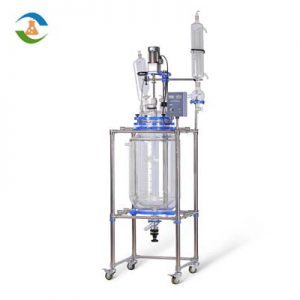S-30L Jacketed Glass Reactor is a kind of laboratory glassware, which is often used for chemical reaction, mixing, heating or cooling of samples. It is designed with a cylindrical glass vessel surrounded by a jacket layer for temperature control. The jacket is usually filled with a heating or cooling medium, such as water or oil, which is circulated through the jacket to regulate the temperature of the vessel contents. The volume of 30L represents the maximum volume of materials that can be processed in the reactor.
The 30L Jacketed Glass Reactor is essential laboratory equipment for performing chemical reactions and is widely used in R&D, pharmaceutical and biotechnology industries for various applications such as crystallization, mixing and filtration.

30L jacketed glass reactor supporting equipment:
1. DLSB-30/60℃ low temperature coolant circulation pump.
DLSB-30/60℃ Low Temperature Coolant Circulation Pump is a laboratory equipment used for cooling and circulating coolant in various applications. It is often used with other laboratory equipment such as rotary evaporators, jacketed glass reactors, and other types of chemical synthesis equipment. Cryogenic coolant circulating pumps are often used in scientific fields such as chemistry and biotechnology that require precise temperature control. They are essential equipment for experiments requiring cryogenic environments, such as reaction studies and crystal growth.
2. SHZ-C circulating water vacuum pump.
SHZ-C Circulating Water Vacuum Pumps are commonly used in laboratory environments to perform tasks such as vacuum filtration, solvent extraction and distillation. They are especially suitable for applications requiring low to medium vacuum levels as they are capable of generating vacuum pressures as low as 0.098MPa.
Circulating water vacuum pumps are invaluable tools for creating vacuum conditions in laboratory environments. It is widely used in many different applications such as filtration, degassing and solvent extraction and is an essential part of many laboratory setups.
3. GYY-30L high temperature circulating oil bath.
High temperature circulating oil bath is a laboratory instrument used to keep chemical reactions and experiments at a constant temperature. It consists of a heating element and a container filled with oil that is circulated to maintain an even temperature. These baths are capable of high temperatures and are used in a variety of fields, including chemistry, biology and materials science.

Advantages of 30L jacketed glass reactor:
The 30L jacketed glass reactor has several advantages that make it a popular choice for laboratory experiments and research. Some of the advantages of the 30L Jacketed Glass Reactor include:
- Temperature control: The jacket design allows precise temperature control of the reaction, which is critical for many chemical and biochemical processes. The outer layer of the reactor is filled with a circulating fluid, such as water or oil, which helps maintain a constant temperature.
- Visibility: The glass structure of the reactor makes it easy to monitor the reaction, which is very important for observing changes in color, phase or other properties. This is also helpful for troubleshooting or optimizing reaction conditions.
- Versatility: The 30L size reactor provides a large working volume that can accommodate various sample sizes and reaction volumes. This makes it a versatile tool for a wide variety of laboratory applications.
- Durability: The glass material used to construct the reactor is resistant to many chemicals and can withstand high temperatures, making it a durable piece of equipment.
- Easy to clean: The glass surface of the reactor is smooth and easy to clean, which is very important for maintaining sterile and pollution-free reaction conditions.
The 30L Jacketed Glass Reactor is a reliable and versatile tool for laboratory applications requiring precise temperature control and reaction visibility. Its durability, easy-to-clean surface, and large working volume make it a popular choice for many researchers and chemists.

30L jacketed glass reactor application:
The 30L Jacketed Glass Reactor is a laboratory equipment commonly used in chemical reactions and can be used for a wide range of experiments and applications, including:
- Chemical reactions: This reactor can be used for various chemical reactions that require controlled temperature and mixing conditions, such as synthesis, hydrogenation and oxidation.
- Biological reaction: The reactor can also be used for biological reactions such as fermentation, cell culture, and protein expression that require precise temperature control and sterile conditions.
- Distillation: This reactor can be used for distillation processes that require precise temperature control and reaction visibility, such as fractional distillation or reflux distillation.
- Solvent extraction: This reactor can be used for solvent extraction processes that require controlled temperature and mixing conditions, such as liquid-liquid extraction or solid-liquid extraction.
- Polymerization: This reactor can be used for polymerization processes that require controlled temperature and mixing conditions, such as emulsion polymerization or suspension polymerization.
- Crystallization: This reactor can be used in the crystallization process that needs to control the temperature and reaction visibility, such as cooling crystallization or evaporative crystallization.
The 30L Jacketed Glass Reactor is widely used, including chemical synthesis, polymerization, distillation and other reactions that require precise control of temperature, pressure and mixing. The 30L Jacketed Glass Reactor is ideal for the production of pharmaceuticals, chemicals and other high-value products that require strictly controlled reaction conditions.

30L jacketed glass reactor operation method:
The operation method of the 30L jacketed glass reactor varies according to the specific model and application, but in general, the following steps outline a basic operating procedure:
- Prepare the reactor: Make sure the reactor is clean and dry before use. Inspect the reactor for any cracks or damage, and check that all components are properly assembled.
- Filling the jacket: Fill the jacket around the reactor with circulating fluid such as water or oil to provide temperature control during the reaction. Connect the jacket inlet and outlet ports to a temperature controller or cooler to maintain a consistent temperature.
- Add the reaction mixture: Add the reaction mixture to the kettle through the top opening, being careful not to overfill. If the reaction is exothermic, use a thermocouple to monitor the reaction temperature.
- Start stirring: Turn on the stirrer to mix the reaction mixture. The speed of the stirrer can be adjusted according to the requirements of the reaction.
- Monitor the reaction: Observe the reaction through the glass surface of the reactor to ensure it is proceeding as expected. If necessary, adjust temperature, stirring speed, or other variables to optimize reaction conditions.
- Terminate the reaction: Once the reaction is complete, turn off the agitator and stop circulating fluid flow through the jacket. Carefully remove the reaction mixture from the autoclave through the bottom valve.
- Clean the reactor: After the reaction is complete, clean the reactor thoroughly with an appropriate solvent to remove any residue and ensure it is ready for the next use.
Always follow the manufacturer’s instructions and any relevant safety guidelines when operating your 30L Jacketed Glass Reactor, and consult an experienced professional or supervisor should any questions arise.
Parameter
Single layer glass reactor
| Model | Stirring Power(W) | Stirring Speed(rmp) | Heating Power(kW) | Capacity(L) | Temperature Using Range(℃) | Motor Torque(g/cm) |
| F-1L | 60 | 0~1000 | 0.5 | 1 | RT-250/RT-350 | 2000 |
| F-2L | 60 | 0~1000 | 0.8 | 2 | RT-250/RT-350 | 2400 |
| F-3L | 60 | 0~1000 | 1.2 | 3 | RT-250/RT-350 | 2400 |
| F-5L | 60 | 0~1000 | 1.5 | 5 | RT-250/RT-350 | 4800 |
| F-10L | 120 | 60~600 | 3 | 10 | RT-250/RT-350 | 1000 |
| F-20L | 120 | 60~600 | 4.5 | 20 | RT-250/RT-350 | 1200 |
| F-30L | 120 | 60~600 | 6 | 30 | RT-250/RT-350 | 1200 |
| F-50L | 120 | 60~600 | 7 | 50 | RT-250/RT-350 | 1500 |
| F-100L | 180 | 60~600 | 9 | 100 | RT-250/RT-350 | 3000 |
Jacketed glass reactor
| Model | Power(W ) | Stirring Speed(rmp) | Diameter | Capacity(L) | Power Supply | Motor Torque(g/cm) |
| S-1L | 60 | 0~600(Max.1300) | 12 | 1 | 220V 50/60 Hz | 2000 |
| S-2L | 60 | 0~600(Max.1300) | 12 | 2 | 220V 50/60 Hz | 2400 |
| S-3L | 60 | 0~600(Max.1300) | 12 | 3 | 220V 50/60 Hz | 2400 |
| S-5L | 60 | 0~600(Max.1300) | 12 | 5 | 220V 50/60 Hz | 4800 |
| S-10L | 120 | 0~600(Max.1300) | 12 | 10 | 220V 50/60 Hz | 1000 |
| S-20L | 120 | 0~600(Max.1300) | 12 | 20 | 220V 50/60 Hz | 1200 |
| S-30L | 120 | 0~600(Max.1300) | 12 | 30 | 220V 50/60 Hz | 1200 |
| S-50L | 120 | 0~600(Max.1300) | 12 | 50 | 220V 50/60 Hz | 1500 |
| S-100L | 250 | 0~600(Max.1300) | 15 | 100 | 220V 50/60 Hz | 3000 |
FAQ:
1. What is 30L Jacketed Glass Reactor?
30L Jacketed Glass Reactor is a laboratory equipment consisting of a glass vessel and a surrounding jacket. The jacket is filled with circulating fluid to control the reaction temperature in the glass vessel. It is commonly used in chemical and biological reactions that require precise temperature control and reaction visibility.
2. How to choose a 30L jacketed glass reactor?
When selecting a 30L Jacketed Glass Reactor, please consider the desired temperature range, pressure rating, agitator type and speed, and required accessories such as temperature controllers, coolers, or vacuum pumps. It is also important to choose a reputable manufacturer and supplier.
3. What are the applications of the 30L jacketed glass reactor?
30L Jacketed Glass Reactors are commonly used for chemical and biological reactions, distillation, solvent extraction, polymerization and crystallization, and other laboratory applications.





